Cpd examination 1 - Study guides, Class notes & Summaries
Looking for the best study guides, study notes and summaries about Cpd examination 1? On this page you'll find 50 study documents about Cpd examination 1.
Page 2 out of 50 results
Sort by
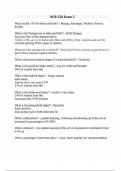
-
NUR 230 Exam 2
- Exam (elaborations) • 16 pages • 2024
-
- $12.00
- + learn more
What are the 5 P's for labor and birth? - Passage, Passenger, Position, Powers, Psyche What is the Passageway in labor and birth? - Birth Passage Size and Type of the maternal pelvis Ability of the cervix to dilate and efface and ability of the vaginal canal and the external opening of the vagina to distend What does the passageway consist of? - Bony pelvis-lower uterine segment-cervixpelvic floor muscles-vagina-introitus What is the most common shape of a maternal pelvis? - Gynecoid ...
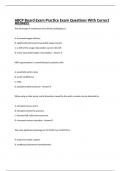
-
ABCP Board Exam Practice Exam Questions With Correct Answers
- Exam (elaborations) • 60 pages • 2024
-
- $13.49
- + learn more
The advantage of continuous warm blood cardioplegia is: A: increased oxygen delivery B: significantly decreased myocardial oxygen tension C: a shift of the oxygen dissociation curve to the left D: lower myocardial oxygen consumption - Answer A IABP augmentation is contraindicated in patients with: A: prosthetic aortic valves B: aortic insufficiency C: VSDs D: peripheral atherosclerosis - Answer B When using a roller pump. aortic dissection caused by the aortic cannula may be de...
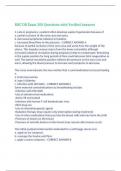
-
RNC OB Exam 300 Questions with Verified Answers,100% CORRECT
- Exam (elaborations) • 94 pages • 2024
-
- $13.49
- + learn more
RNC OB Exam 300 Questions with Verified Answers 1. Late in pregnancy, a patient often develops supine hypotension because of a. partial occlusion of the vena cava and aorta. b. decreased peripheral collateral circulation. c. increased blood flow to the placenta. - CORRECT ANSWER A because of partial occlusion of the vena cava and aorta from the weight of the uterus. This impedes venous return from the lower extremities although increased collateral circulation during pregnancy helps to...
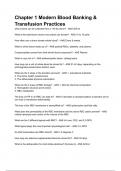
-
Chapter 1 Modern Blood Banking & Transfusion Practices A+ RATED
- Exam (elaborations) • 4 pages • 2024
-
- $16.18
- + learn more
Chapter 1 Modern Blood Banking & Transfusion Practices A+ RATED what volume can be collected from a 110 lbs donor? - ANS 525 ml What is the total blood volume mos adults can donate? - ANS 10 to 12 pints How often can a donor donate whole blood? - ANS Every 8 weeks. What is whole blood made up of? - ANS packed RBCs, platelets, and plasma. Cryoprecipitate comes from what whole blood component? - ANS Plasma What is cryo rich in? - ANS antihemophilic factor- clotting factor. How l...
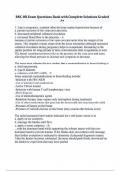
-
RNC-OB Exam Questions Bank with Complete Solutions Graded A+
- Exam (elaborations) • 86 pages • 2024
- Available in package deal
-
- $15.00
- + learn more
1. Late in pregnancy, a patient often develops supine hypotension because of a. partial occlusion of the vena cava and aorta. b. decreased peripheral collateral circulation. c. increased blood flow to the placenta. - A because of partial occlusion of the vena cava and aorta from the weight of the uterus. This impedes venous return from the lower extremities although increased collateral circulation during pregnancy helps to compensate. Remaining in the supine position for long periods of ...
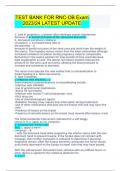
-
TEST BANK FOR RNC-OB Exam 2023/24 LATEST UPDATE
- Exam (elaborations) • 128 pages • 2023
-
- $15.49
- + learn more
TEST BANK FOR RNC-OB Exam 2023/24 LATEST UPDATE 1. Late in pregnancy, a patient often develops supine hypotension because of a. partial occlusion of the vena cava and aorta. b. decreased peripheral collateral circulation. c. increased blood flow to the placenta. - A because of partial occlusion of the vena cava and aorta from the weight of the uterus. This impedes venous return from the lower extremities although increased collateral circulation during pregnancy helps to compensate. Rema...
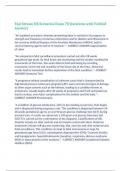
-
Fast Stream OB Scenarios Exam 78 Questions with Verified Answers,100% CORRECT
- Exam (elaborations) • 20 pages • 2024
-
- $11.39
- + learn more
Fast Stream OB Scenarios Exam 78 Questions with Verified Answers "An inpatient procedure whereby preexisting labor is assisted in its progress in strength and frequency of uterine contractions and/or dilation and effacement in the cervix by Artificial Rupture of the Amniotic Membranes (AROM), and/or cervical ripening agents and/or IV oxytocin." - CORRECT ANSWER Augmentation of Labor "An antepartum fetal surveillance procedure carried out after 28 weeks gestational age exam. By fetal hea...
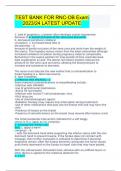
-
TEST BANK FOR RNC-OB Exam 2023/24 LATEST UPDATE
- Exam (elaborations) • 128 pages • 2023
-
- $15.99
- + learn more
TEST BANK FOR RNC-OB Exam 2023/24 LATEST UPDATE 1. Late in pregnancy, a patient often develops supine hypotension because of a. partial occlusion of the vena cava and aorta. b. decreased peripheral collateral circulation. c. increased blood flow to the placenta. - A because of partial occlusion of the vena cava and aorta from the weight of the uterus. This impedes venous return from the lower extremities although increased collateral circulation during pregnancy helps to compensate. Rem...
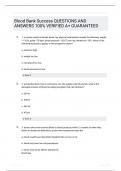
-
Blood Bank Success Study Guide Questions and Correct Answers
- Exam (elaborations) • 50 pages • 2024
-
- $17.24
- + learn more
Blood Bank Success Study Guide Questions and Correct Answers 1. A woman wants to donate blood. Her physical examination reveals the following: weight—110 lb, pulse—73 bpm, blood pressure—125/75 mm Hg, hematocrit—35%. Which of the following exclusions applies to the prospective donor? A. Pulse too high B. Weight too low C. Hematocrit too low D. Blood pressure too low 2. A potential donor has no exclusions, but she weighs only 95 pounds. What is the allowable amount of blood...
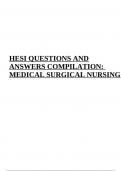
-
HESI QUESTIONS AND ANSWERS COMPILATION | MEDICAL SURGICAL NURSING 2023 | 2024
- Exam (elaborations) • 218 pages • 2023
-
- $23.49
- + learn more
HESI QUESTIONS AND ANSWERS COMPILATION: MEDICAL SURGICAL NURSING 2023 | 2024. A client has been told of a positive breast biopsy report. She asks no questions and leaves the healthcare provider’s office. She is overheard telling her husband, :the doctor didn’t find a thing.” What coping style is operating at this stage of grief? - Denial 3. Your client, an incest survivor, is speaking of her deceased father, the perpetrator. “He was a wonderful man, so good and kind. Everyone though...

Did you know that on average a seller on Stuvia earns $82 per month selling study resources? Hmm, hint, hint. Discover all about earning on Stuvia


